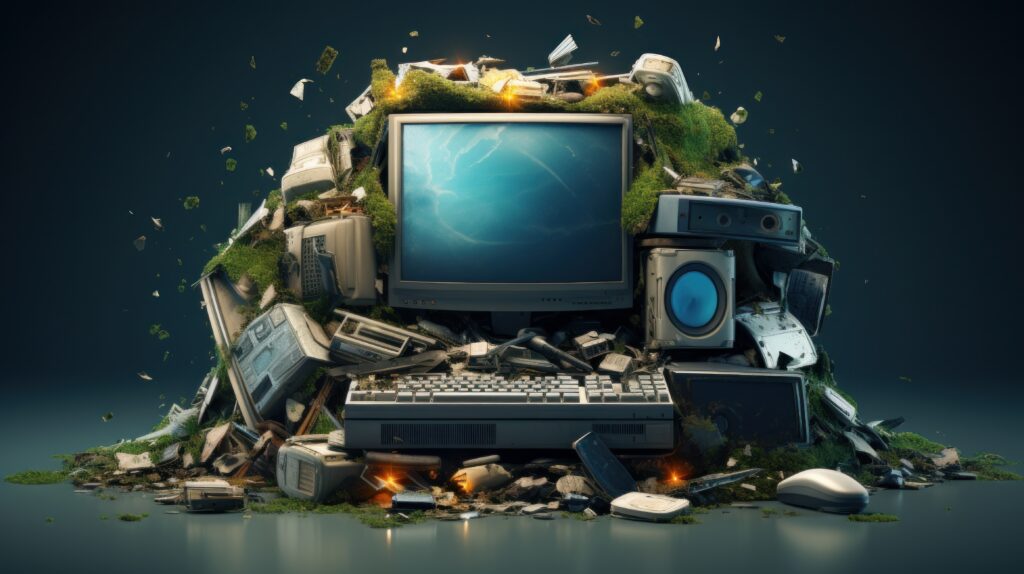Solving the e-waste problem
If the internet were a country, it’d be the 3rd largest consumer of energy in the world. Yet, rarely is much thought given to the e-waste being generated by devices and the petabytes of data we are constantly creating.
As the internet finally takes over, how do we mitigate the damage it has on our environment? What can businesses do to ensure they are financially, reputationally and operationally ready for the next wave of environmental regulations?
Getting the measure of e-waste
Like any other type of pollution, e-waste takes several forms. Firstly, there is physical e-waste, or hardware. Devices like old mobile phones and computers contain acids and harmful chemicals which can pollute waterways, soil, air, and even enter our food chain.
The energy used to delete 30 emails could power a standard lightbulb for 24 hours.
Virtual e-waste, however, such as information platforms, software, and systems, can be no less harmful. How many emails does your organization send in a single day? Globally we send around 10 billion every 24hrs, but just one email emits 10g of CO2, which is the same carbon footprint as a plastic bag. The energy used to delete 30 emails could power a standard lightbulb for 24 hours.

The continued rise of cloud computing and the Internet of Things is only exacerbating the problem; computers, smartphones, data centers, networks and connected objects already consume 10% of the world’s electricity. In total, the carbon footprint of the internet and connected devices account for about 3.7% of global greenhouse emissions, which is more than the airline industry (2.4%). This figure is expected to double by 2025.
Europe generates the most e-waste per capita, followed by North America and Asia. Developed countries are responsible for most of the pollution, but it often ends up going to landfill in developing countries. India, parts of Africa, and other Asian countries are involved in the ‘recycling’ of e-waste, but often this waste is simply burned. One of the world’s biggest e-waste dumps was in Guiyu, in the Guangdong province of southern China. Although regulators have since stepped in to clean up the area, it now has some of the world’s highest recorded concentrations of dioxins and heavy metals, and the town’s water contained lead 2,400 times higher than safe levels.
Turning the tide on e-waste polluters
The UN’s environmental chief Achim Steiner, Executive Director of the UN Environment Programme (UNEP), has already warned of a “tsunami of e-waste rolling out over the world”. Globally, different countries have different regulations pertaining to the disposal of e-waste, but the European Union’s Directives on Waste Electrical and Electronic Equipment (WEEE) and Restriction of Hazardous Substances (RoHS) are setting the bar so far.
Consumers are undeniably becoming more eco-conscious, and influences such as David Attenborough’s Blue Planet – the documentary caused public outcry over plastic pollution – are waking up society to the perils of leaving ecologically polluting forces unchecked. If they want to remain in public favor, companies must be proactive in moving towards a greener, more sustainable way of doing business.
Towards a solution
As well as reducing IT expenses and boosting efficiency and agility, virtualization is a viable way for organizations to reduce their carbon footprint and e-waste.
Involving computer-generated versions of hardware, operating systems, storage devices and networks, virtualization allows a single device to become multiple virtual resources. Each virtual machine can then operate independently from the physical one, resulting in fewer overall servers, less energy consumption and fewer infrastructure costs and maintenance.
There are numerous types of virtualization depending on an organization’s need. These include hardware, sever, network, application, storage and desktop.
While virtualization is not a ‘silver bullet’ in solving the e-waste problem, it greatly impacts an organization’s need for physical devices, lessening the burden on recycling facilities. Prevention is better than cure; reducing demand for technology through virtualization is a big step towards a greener business environment.
How we’re helping
Amaris Consulting, part of the Mantu brand platform, specializes in helping to shape and drive businesses’ transformation journey. With a dedicated Global Center of Excellence in Telecoms and technology consultants in over 60 countries, we help our clients design, shape, and operate their next generation network infrastructure.
Amaris Consulting’s Telecoms and Technology expertise meant we were selected as the right partner to complete a large-scale SDN project with a global telecoms and IT company. Software-defined networking (SDN) is an implementation of network virtualization. It reduces demand on electronic resources, lowers carbon footprint, and lessens the emission of hazardous gases into the environment.
SDN technology can be widely used for many network solutions, such as data center virtualization and cloud computing. With the help of SDN, network administrators can dynamically change or modify the network configurations based on the business requirements instead of manually configuring networking devices like switches & routers.
Amaris consultants worked to implement our client’s SDN solution for their various clients, including major global technology, telecoms, and insurance firms. Our skilled consultants configured, maintained & monitored our client’s SDN solution in their clients’ environment throughout the APAC region.